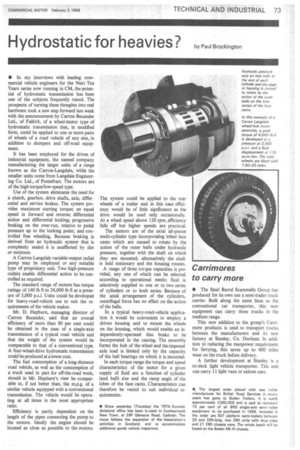Hydrostatic for heavies? by Paul Brockington
Page 75

If you've noticed an error in this article please click here to report it so we can fix it.
• In my interviews with leading commercial vehicle engineers for the Next Ten Years series now running in CM, the potential of hydrostatic transmission has been one of the subjects frequently raised. The prospects of turning these thoughts into real hardware took a new step forward last week with the announcement by Carron Becander Ltd., of Falkirk, of a wheel-motor type of hydrostatic transmission that, in modified form, could be applied to one or more pairs of wheels of a road vehicle of any size, in addition to dumpers and off-road equipment.
It has been employed for the drives of industrial equipment, the named company manufacturing the larger units of a range known as the Carron-Langdale, while the smaller units come from Langdale Engineering Co. Ltd., of Pontefract. The motors are of the high-torque/low-speed type.
Use of the system eliminates the need for a clutch, gearbox, drive shafts, axle, differential and service brakes. The system provides maximum starting torque; an equal speed in forward and reverse; differential action and differential locking; progressive braking on the over-run, relative to pedal pressure up to the locking point; and controlled free wheeling. Because braking is derived from an hydraulic system that is completely sealed it is unaffected by dirt or moisture.
A Carron-Langdale variable-output radial pump may be employed or any suitable type of proprietary unit. Two high-pressure outlets enable differential action to be controlled as required.
The standard range of motors has torque ratings of 140 lb ft to 26,000 lb ft at a pressure of 3,000 p.s.i. Units could be developed for heavy-road-vehicle use to suit the requirements of the vehicle maker.
Mr. D. Hepburn, managing director of Carron Becander, said that an overall efficiency of more than 80 per cent could be obtained in the case of a single-axle transmission of a typical road vehicle and that the weight of the system would be comparable to that of a conventional type. A four-wheel-drive hydrostatic transmission could be produced at a lower cost.
The fuel consumption of a long-distance road vehicle, as well as the consumption of a truck used in part for off-the-road work, should in Mr. Hepburn's view be comparable to, if not better than, the m.p.g. of a similar vehicle equipped with a conventional transmission. The vehicle would be operating at all times in the most appropriate ratio.
Efficiency is partly dependent on the length of the pipes connecting the pump to the motors. Ideally the engine should be located as close as possible to the motors. The system could be applied to the rear wheels of a trailer and in this case efficiency would be of little signficance as the drive would be used only occasionally. At a wheel speed above 120 rpm, efficiency falls off but higher speeds are practical.
The motors are of the axial all-piston multi-cylinder type incorporating lobed face cams which are caused to rotate by the action of the outer balls under hydraulic pressure, together with the shaft on which they are mounted; alternatively the shaft is held stationary and the housing rotates.
A range of three torque capacities is provided, any one of which can be selected according to operational needs; fluid is selectively supplied to one or to two series of cylinders or to both series. Because of the axial arrangement of the cylinders, centrifugal force has no effect on the action of the balls.
In a typical heavy-road-vehicle application it would be convenient to employ a driven housing and to mount the wheels on the housing, which would enable an independently-operated disc brake to be incorporated in the casting. The assembly forms the hub of the wheel and the imposed axle load is limited only by the capacity of the ball bearings on which it is mounted.
In each torque range the torque and speed characteristics of the motor for a given supply of fluid are a function of cylinder (and ball) size and the ramp angle of the lobes of the face cams. Characteristics can therefore be varied to suit individual requirements.
• Since yesterday (Thursday) the TRTA Scottish divisional office has been loLated in Cumbemauld New Town, at 28F Glenacre Road, Carbrain. The move follows the expansion of the Association's activities in Scotland, and to accommodate additional goods vehicle inspectors.




































































































































































































